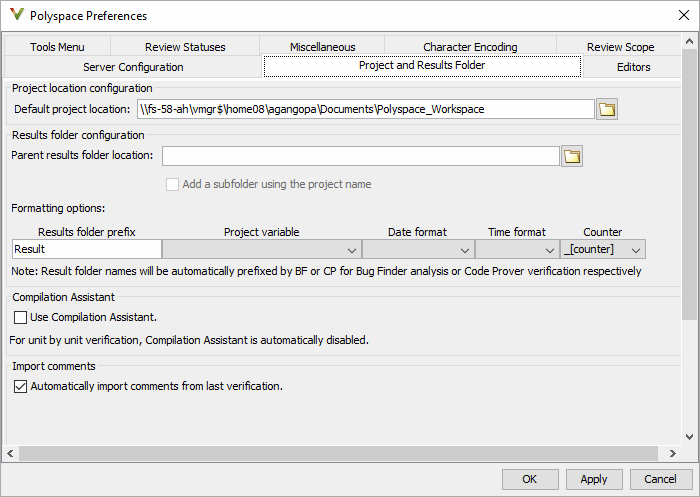Customize Polyspace Desktop User Interface
You can customize various aspects of the Polyspace® user interface, for instance, default project storage locations or default font size of source code. Select Tools > Preferences.

Possible Customizations
Change Default Font Size
To change the default font size in the Polyspace user interface, select the Miscellaneous tab.
To increase the font size of labels on the user interface, select a value for GUI font size.
For example, to increase the default size by 1 point, select
+1.To increase the font size of the code on the Source pane and the Code Editor pane, select a value for Source code font size.
When you restart Polyspace, you see the increased font size.
Specify External Text Editor
You can change the default text editor for opening source files from the Polyspace interface. By default, if you open your source file from the user interface, it opens on a Code Editor tab. If you prefer editing your source files in an external editor, you can change this default behavior.
To change the text editor, select the Editors tab. From the Text editor drop-down list, select External. In the Text editor field, specify the path to your text editor. For example:
C:\Program Files\Windows NT\Accessories\wordpad.exe
To make sure that your source code opens at the
correct line and column in your text editor, specify
command-line arguments for the editor using Polyspace macros, $FILE, $LINE and
$COLUMN. Once you specify the arguments, when you
right-click a check on the Results List pane and select
Open Editor, your source code opens at the location of
the check.
Polyspace has already specified the command-line arguments for these
editors: Emacs, Notepad++
(Windows® only), UltraEdit,
VisualStudio, WordPad
(Windows only) or gVim. If you are using one of
these editors, select it from the Arguments drop-down list.
If you are using another text editor, select Custom
from the drop-down list, and enter the command-line options in the field
provided.
For console-based text editors, you must create a terminal. For example, to
specify vi:
In the Text Editor field, enter
/usr/bin/xterm.From the Arguments drop-down list, select
Custom.In the field to the right, enter
-e /usr/bin/vi $FILE.
To revert back to the built-in editor, on the Editors tab, from the Text editor drop-down list, select Built In.
Create Naming Convention for Results Folder
By default, results are stored in a subfolder of the project folder. When you run an analysis, you can overwrite the results of the previous run or create a new results folder.

You can customize the results folder on the Project and Results Folder tab in these ways:
If you create a new results folder for each run, you can define a naming convention for the folder. To specify a results folder naming convention, in the section Results folder configuration, use the options under Formatting options to create a naming convention for results folders.
For instance, the results folder naming convention below uses the module name and date and time of analysis. So, a Bug Finder result folder using this convention has a name such as
BF_Result_module_2_01_01_2020_22_30.
You can store results separately from projects. In the section Results folder configuration, you can specify a root folder for storing results and store per-project results in subfolders of the root folder:
Specify the root folder for Parent results folder location.
Select the option Add a subfolder using the project name.
Create Custom Review Status
When reviewing Polyspace results, you can assign a status such as To fix
or Justified. See Address Results in Polyspace User Interface Through Bug Fixes or Justifications.
You can also create and assign custom statuses. To create a new status:
Select the Review Statuses tab.
Enter the status in the Add a new status field and click Add.
Optionally, to specify that Polyspace should consider results with this review status justified, select the checkbox next to the Add button. See also Address Results in Polyspace User Interface Through Bug Fixes or Justifications.
Storage of Polyspace User Interface Customizations
The software stores the settings that you specify through the Polyspace Preferences in the following file:
Windows:
$Drive\Users\$User\AppData\Roaming\MathWorks\MATLAB\$Release\Polyspace\polyspace.prfLinux®:
/home/$User/.matlab/$Release/Polyspace/polyspace.prf
Here, $Drive is the drive where the
operating system files are located such as C:,
$User is the username and
$Release is the release number.
The following file stores the location of all installed Polyspace products across various releases:
Windows:
$Drive\Users\$User\AppData\Roaming\MathWorks\MATLAB\polyspace_shared\polyspace_products.prfLinux :
/home/$User/.matlab/polyspace_shared/polyspace_products.prf